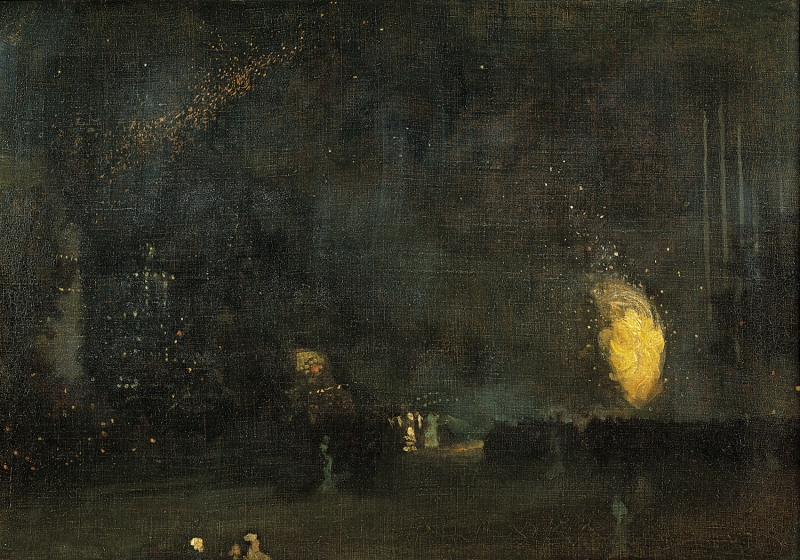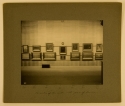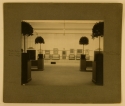Composition
There is a small watercolour copy done by Whistler many years afterwards, Copy of 'Nocturne: Black and Gold - The Fire Wheel' [M.1359], which, although much smaller in scale, helps to clarify the original appearance of the painting.
Technique
Taylor noted that while the figures were painted with conventional, if slightly decorative, brushwork, the cascades of sparks and spent fireworks were deliberately dripped on to the surface. 1 This is not entirely true – most of the dots were placed deliberately by painting them neatly and with precision on the dark background. As Marc Simpson points out, the sparks were painted carefully and 'intentionally situated in their direction and focus so as to imply the depth of their burst and scatter.' 2
The fountain, barely visible on the left, is also indicated by tiny spots of colour, although it is possible – comparing Whistler's pen drawing of 1888, and the photograph published in 1892, with the present state of the painting – that it originally stood out more than it does now.
Professor Joyce H. Townsend has written a detailed report based on a visual and technical examination of the painting:
'Whistler’s own watercolour after the painting, likely gives a good impression of what has been lost to contemporary viewers.
X-radiography did not reveal previous use of the canvas nor recognisable changes in composition, though the details of the painting are difficult to discern today, when comparing the number of rockets and sparks. The X-radiograph suggests more of these than can be recognised today, but it is impossible to tell whether Whistler effaced some, if varnish removal also removed paint from some, or whether they lie swamped beneath the varnishes today. Examination in raking light does not suggest compositional changes either. It does confirm what the microscope can also show: that the very fine canvas was excessively rubbed down by the artist, with the tops of the canvas threads visible all over the surface, and to a greater extent than often occurs. This is what caused such dramatic absorption of lining adhesive, through the whole depth of the canvas and up into the paint.
The canvas was not primed, but was presumably sized. Whistler applied a warm dark grey imprimatura made from lead white, bone black and cadmium yellow. It too can be glimpsed through the microscope, where the rubbing down reached the canvas threads. This of itself would have led to some darkening as the paint aged, an optical phenomenon that occurs as paint applied over a mid-toned or darker layer grows more transparent with age.
Even with the microscope, it is nearly impossible to see what Whistler painted. Blue glazes and runs of dull olive green paint can be seen, but their function is none too clear. Bright red vermilion, red ochre, the deep blue of natural ultramarine, cobalt or cerulean blue, raw umber and ivory black can be recognised. The red fireworks in fact were painted in an orange tone. The fire wheel itself includes pure white that could be mistaken now for yellow ochre, glazes of intense chrome yellow, likely chrome orange, and a red organic colorant which is the only one in this list that might be subject to fading when exposed to light. Elsewhere, vermilion, chrome yellow, chrome orange and Prussian blue were employed. The palette is less tightly controlled in this painting than in the nocturnes, and it is possible that not all the colours employed have even been recognised in this examination.
No treatment has been carried out since 1959, because the optical effects of darkening caused by lining, darkening of the paint medium, and the use of an underlayer much darker than a mid-tone cannot be much ameliorated by removal of the yellowed varnishes. The extensive rubbing-down would also make varnish removal extremely challenging.' 3
Conservation History
Nocturne: Black and Gold - The Fire Wheel [YMSM 169] may have been sent to Stephen Richards (1844-1900) for some treatment, as Whistler wrote to him on 12 June 1892:
'About the large Nocturne of Cremorne ... What did you do to this? - I wanted you to clean it and take off whatever varnish there may have been upon it - and send unvarnished, that I might paint upon it. I have not examined it closely - but at first sight it doesn't seem as if you had done anything to it at all?' 4
In 1893 Whistler made a watercolour Copy of 'Nocturne: Black and Gold - The Fire Wheel' [M.1359], which is reproduced above. 5 It is signed with a butterfly on the verso and inscribed in pencil: '"Nocturne in Black and Gold, the Fire Wheel"/ from the original/ April 20th 1893’. It gives a good impression of the painting (as does the photograph taken in 1892 for the Goupil Album) but suggests that it has darkened considerably.
In 1896 the varnish on the painting was replaced by Stephen Richards (1844-1900) under Whistler's directions. He told the new owner, Arthur Haythorne Studd (1863-1919):
'The thing to do will be to let Richardson [sic] have the picture - and I will see him tomorrow morning and preside myself at the varnishing - After all it is his own varnish that was upon it - and he will therefore be full of care and everything will come right at once - Doubtless the two journeys over the ocean have chilled the varnish - but the painting is in its perfect condition.' 6
He instructed Richards in the treatment required:
'If you are able tomorrow morning, when you get this, the first thing I wish you would go to Mr. Arthur Studds 97 Cheyne Walk - Chelsea -
I want you to take with you the materials for varnishing a picture of mine that is hanging in his drawing room -
You doubtless will remember it - having varnished it a few years ago at the time of the Exhibition at Messrs. Goupil in the old Bond Street rooms - a Nocturne, "The Firewheel". -
The picture has just come back from America - and though perfectly clean - I washed it myself this afternoon - is in a very dull state - The varnish is quite chilled, and much sunken in -
It is quite ready to have another coat of varnish - your very best! - So give a thin coat tomorrow morning - This will go perfectly, ... and you will have got again the beautiful enamel surface that you know I so greatly admire -
You had better give the picture a gentle rub, with your chamois leather first - ... I want you to make a beautiful job of this - If you do, Mr. Studd, to whom I have already spoken, will, I am sure, have you down in future to take care of his pictures.' 7
The operations concluded, Whistler told Studd:
'Your picture is splendid!
I have been with Richards - and the old varnish, in its perished state, was removed under my supervision - and today the new coat of varnish was put on -
The painting is in a lovely condition and you have never before seen your picture as you now will see it - It is most brilliant ... as if it had left the easel yesterday -
Richards thinks it better to keep it until Monday so that it may dry thoroughly - before risking the journey.' 8
Whistler also reported to E. G. Kennedy, who had returned the picture to London earlier in the year:
'The Firewheel arrived in pitiable condition! All the varnish perished - and the background quite invisible - covered with patches of dim grey - No wonder no one could see anything in it - Had it at once cleaned, revarnished - Beautiful again! - Sold at once for 1000 guineas - So thats all right ... What is the cause? Can it be the salt air crossing?' 9
It seems it required further treatment in 1900, and was sent to the Maison Chapuis in Paris for the varnish to be removed and restoration effected under Whistler's direction: on 4 April, Studd enquired 'if I am soon to welcome it back to my drawing room - I hope you do not think I am unworthy of taking charge of it.' 10
A recent report by Professor Joyce H. Townsend adds valuable details on the technique, condition and conservation of the painting:
'It is unclear whether Whistler requested restorer Stephen Richards to remove the varnish in 1892 so that he (Whistler) could work on it, but in 1896 he certainly did have Stephens remove and replace it. Whistler’s written phrase, "After all it is his own varnish that was upon it", 11 does suggest this was a second removal, albeit the first re-varnishing, done because the varnish was "chilled" and "sunken in" by travelling twice across the Atlantic, by ship. This means, that the surface looked cloudy instead of transparent, not necessarily that it was yellowed. Exposure of a natural resin varnish to a damp environment was said to cause chilling. Whistler himself "washed" the surface prior to this re-varnishing, which means that he had removed grime from the surface of the varnish with water. Whistler requested Stephens to give a gentle rub with chamois leather, which would counteract the chilling, followed by a thin coat of presumed natural resin varnish, which would have been applied with a brush.
By 1959 the painting had a yellowed, tinted varnish of natural resin – not that of 1896, since by then the canvas had been trimmed, lined with glue paste, and put onto a new stretcher, by the Paris-based company whose label ("Maison CHAPUIS / BRIESON Frères, Neveux & Successairs / Retoileurs de Musées nationaux / 20, Quai de la Megisserie / Rue de Bourdonnais") is on the stretcher. In 1959, the surface dirt was removed from this varnish and an additional varnish made from natural resin (mastic) was applied at Tate. It appears that Whistler had authorised the treatment by Maison Chapuis in 1900, but made no comments afterwards concerning its likely altered appearance. From a twenty-first century perspective, the lining impregnated the canvas with lining adhesive, which would immediately have made it appear much darker – and Whistler must have observed this, yet he continued to regard the painting highly. More seriously today, the high temperature employed during lining has by now made the paint medium turn more brown than yellow. Its content of thinners made this change likely, but the liners could not have known of this. Further, regular light exposure in exhibitions and an early owner’s home has led to severe yellowing of the two natural resin varnishes present. There is a fine haze of cracks in the varnishes too.' 12
Frame
1883: The style and whereabouts of the original frame(s) are not known.
1892: Grau Whistler frame made by Frederick Henry Grau (1859-1892): gold leaf (oil gilding) on wood (pine).
Whistler ordered several frames from Grau during the preparations for the Goupil Gallery exhibition of 1892, including this one. He instructed that all his ‘pictures be in good condition – properly framed and glazed.' 13
It appears at upper right in these photographs of the 1904 Boston exhibition.
1919: Soon after its accession by the Tate the frame was altered to make a removable glazing door to protect the painting. This enabled the glazing and painting to be removed from the frame while it was still hung on the wall. The door is indicated by thumbscrew fixings at top-left and right, which are stamped with Tate’s accession number. The frame was re-gilded but eventually the gilding started to flake and the frame became dirty.
Notes:
1: Taylor 1978 [more] , p. 73. (see also Dorment, Richard, and Margaret F. MacDonald, James McNeill Whistler, Tate Gallery, London, Musée d’Orsay, Paris, and National Gallery of Art, Washington, DC, 1994-1995 (cat. no. 56); and Stoner 1995 [more] ).
2: Simpson, Marc, 'Whistler, Modernism, and the Creative Afflatus', in Simpson, Marc, Like Breath on Glass: Whistler, Inness, and the Art of Painting Softly, Sterling and Francine Clark Art Institute, Williamstown, MA, 2008, pp. 24-51, at pp. 37, 47, 48 note 51.
3: Prof. J. H. Townsend, Report, September 2017, GU WPP files.
5: The Hunterian, Glasgow, GLAHA 46175.
6: Whistler to Studd, [24 March 1896], GUW #03153; Studd to Whistler, 4 April 1900, GUW #05613.
7: [2 April 1896], GUW #10722.
8: [4/7 April 1896], GUW #03155.
9: [8/25 April 1896], GUW #09745.
11: Whistler to A. H. Studd, [24 March 1896], GUW #03153.
12: Report by Prof. J. H. Townsend, September 2017.
13: Whistler to D. C. Thomson, 14 February 1892, GUW #08216.
Last updated: 20th May 2021 by Margaret












